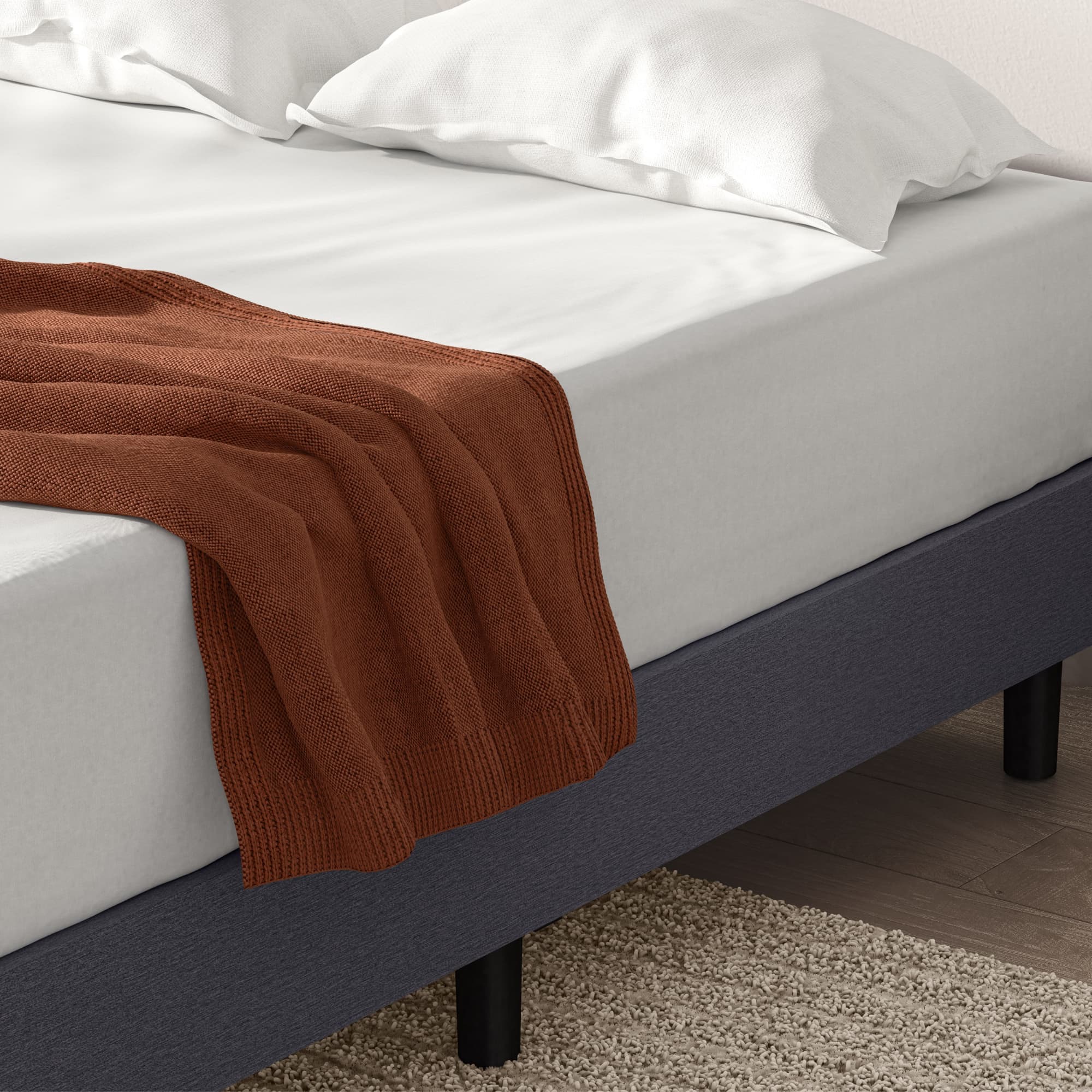You just got a brand-spanking-new mattress. The box is in the recycling, you’re snuggling under fresh sheets, and you close your eyes for a great night’s sleep. But instead of blissful comfort, you face disappointment. Now, reality strikes because the truth is that it can take several nights or even weeks to adjust to a new mattress.
Before you let the kids jump on the bed to break it in or haul your old mattress out of the trash! Know there are better options. The good news is that the following tricks and tips can help you break in your mattress faster.
Understanding mattress materials and break-in time
It takes around three to four weeks to break in a new mattress. Don’t panic—some mattress materials are a little easier to adjust to. Before buying, know the difference your mattress material makes in the break-in process.
Traditional Innerspring Mattress: Shortest break-in time. Some spring mattresses are immediately comfortable. Unfortunately, these mattresses also break down quickly.
Memory Foam Mattress: Average break-in time of around 30 days or less. Memory foam mattresses may be firmer than you expect at first, but they soften over time, sometimes too much, depending on the foam quality.
Hybrid Mattress: Average break-in time of around 30 days. The spring and foam combo lends itself to immediate cushy comfort and durability, but the full break-in still takes some time.
Latex Mattress: Short break-in time of around two weeks or less. Quality latex may take as little as a few days to break in and adjust to the body. The premier materials also hold up incredibly well, giving proper support for years and years.
Mattress break-in time and individual adjustment
The time it takes to adjust to a new mattress can vary depending on the mattress type. But it can also vary depending on the individual. The amount of pressure and wear you place on the mattress will influence the adjustment period.
For example, someone who tosses and turns at night may break in their mattress faster. Similarly, larger folks or those who sleep with a troop of huskies may get a shorter adjustment time. Conversely, a small individual sleeping alone may have to deal with the full adjustment period.
There’s also the mental factor to consider. If you liked the way your old mattress felt—before it started to give you back pain — you're going to miss it. Your body is used to sleeping on a different mattress with slightly different firmness and shape. Mentally, getting used to your new mattress takes time. It’s crucial to be patient and give your body time to adjust to the new mattress, physically and mentally.
That said, there are some tips that can speed up the process.
Tips for a good night’s sleep on a new mattress
Whether you're snoozing on a hybrid, latex, or memory foam bed, these tips and tricks can speed up the mattress adjustment period.
Tip #1: Choosing the right mattress
Choosing the right mattress in the first place is 100% vital for a successful adjustment period. The truth is that you’ll never adjust to the wrong mattress, so it’s essential to find an option that suits your sleep style and preferences. You should consider factors like firmness, material, size, and personal needs when selecting a new mattress. For example, the best mattress for sciatica will differ from the best mattress for allergy sufferers.
Don’t be afraid to ask for recommendations or advice from sleep experts to find the best possible mattress for your needs. Researching different mattress types, including memory foam and latex, can help you make an informed decision. You should also check out Leesa’s buying guide to help you choose.
Tip #2: Let it breathe
Letting your mattress breathe for a few hours after unpacking can help reduce discomfort and improve sleep quality. Most box-delivered mattresses need at least an hour to inflate and a few days to reach full firmness anyway. Any manufacturer or shipping odor also has time to escape when you air it out. Letting it breathe means you shouldn't sit or lie on it and should avoid putting any sheets or protectors on it yet.
Tip #3: Optimize your sleep schedule and environment
Even easy sleepers may have a tough time snoozing on a new bed. Establishing a consistent sleep schedule and creating a sleep-conducive environment can help overcome the unfamiliarity and improve your sleep quality during the adjustment period.
A consistent sleep schedule means you go to sleep and wake up at the same time every day, including weekends. This schedule may be challenging for new parents or those who struggle with insomnia. Just make your best effort to keep a consistent schedule.
Avoiding screens and electronics before bedtime and creating a relaxing bedtime routine can also be beneficial. This is because screens use blue light, a wavelength that may disrupt sleep. Instead, try reading a book, playing a word game, or practicing meditation to wind down.
Tip #4: Get a good frame and mattress topper
Investing in a supportive foundation and using a mattress topper can help improve sleep quality and reduce discomfort. A topper also adds extra comfort during the break-in period, especially if you have a firm mattress. It’s the extra bit of cushiness you may need during this time. A supportive foundation is necessary for a good night’s sleep in general. The right bed frame, base, or foundation can help extend the life of your mattress and help your comfort reach its full potential.
Tip #5: Get some daytime relaxation in
Spend extra time on the mattress during the day. Think along the lines of reading, watching TV, and cuddling with pets. Spending extra time on the mattress can help it break in faster and improve sleep quality. Just a few hours watching TV or reading on your new mattress can help you get used to its feel and comfort.
Just make sure not to fall asleep and nap too much. You don’t want to throw off your sleep schedule.
Tip #6: Don’t avoid the middle or the other side
It's normal to prioritize breaking in your spot on the bed. You want your sleep position of choice to feel comfy as soon as possible. If you're in a couple, though, you risk leaving the middle of the bed as no man's land. The same issue is possible for solo sleepers. Wherever side of the bed you sleep on becomes comfortable for your body, and the other side is left alone.
Rotating the bed is the natural way to fix hard and soft divots in the mattress, but you can also address this issue during the adjustment process. Deliberately spend time relaxing on different parts of the bed. You don't have to sleep in the middle of the bed, but plop up on this part of the mattress when it's time for a midday movie marathon.
Tip #7: Be patient
Remember that it may take some time to adjust to a new mattress fully, but with patience and the right tips, you can enjoy a good night's sleep. Give yourself the entire 30-day typical adjustment period before you second-guess your mattress choice.
Tip #8: Look for a sleep trial
fSometimes, it just doesn’t work out. You may use all the tips and give your mattress a few months to try, but you may never fully adjust. Most likely, you have the wrong mattress for your sleep needs. While this case is rare, it can happen, and choosing a mattress with a sleep trial period may provide peace of mind when purchasing a new mattress. The best trial periods, like those from Leesa, are 120 days long.
How do I know if my mattress discomfort is part of the normal adjustment period or if I chose the wrong mattress?
Sometimes it's hard to tell. It's also normal to be nervous about your mattress purchase. It is where you are supposed to get the rest you need, after all. Consider the following two rules when deciding if your discomfort is a part of the adjustment process or something else entirely.
The normal adjustment irritation should gradually improve over several weeks.
Any pain is not normal and may indicate the mattress isn't right for your body.
Remember, you can take advantage of sleep trials if you’ve ended up with the wrong mattress.
Is it normal for my new mattress to feel uncomfortable at first?
This is a tricky one. In general, no. It shouldn't be truly uncomfortable when lying on your new mattress for the first time. Initial slight discomfort is common, especially when switching between significantly different firmness levels or materials, but true, intense discomfort is not right.
Remember that your mattress is made of plush, comfortable materials designed to cradle your body. An immediate uncomfortable sensation means the mattress is not right for you. However, if you feel slightly uncomfortable after lying on the mattress for some time, this may be a part of the normal adjustment period.
Can I jump on my mattress to break it in?
As fun as this could be, your new mattress isn’t a trampoline. Mattresses tend to break under high pressure, and your body won’t fare well after slipping off a mattress, either. Light pressure, like the activities mentioned in tip #5, is really all you need.
Adjust your sleep with the right Leesa mattress
It doesn't take a magic wand to adjust to your new mattress. Just some time, tips, and dedication to good sleep. Remember to choose the right mattress for your needs, get a quality bed base, and mattress topper, and give your body (and mind) time to adjust.All Leesa mattresses come with a 120-day sleep trial, so if it’s just not working out, you can return it or try again with a different model. You deserve better, quality sleep. Get it here at Leesa.
.jpg&w=3840&q=75)


